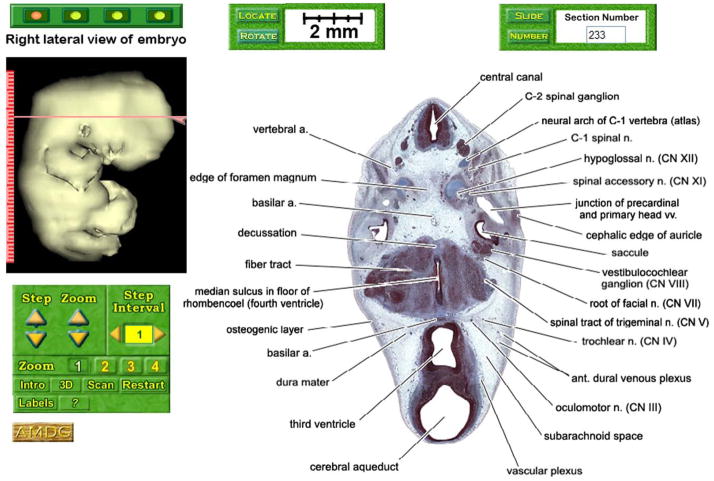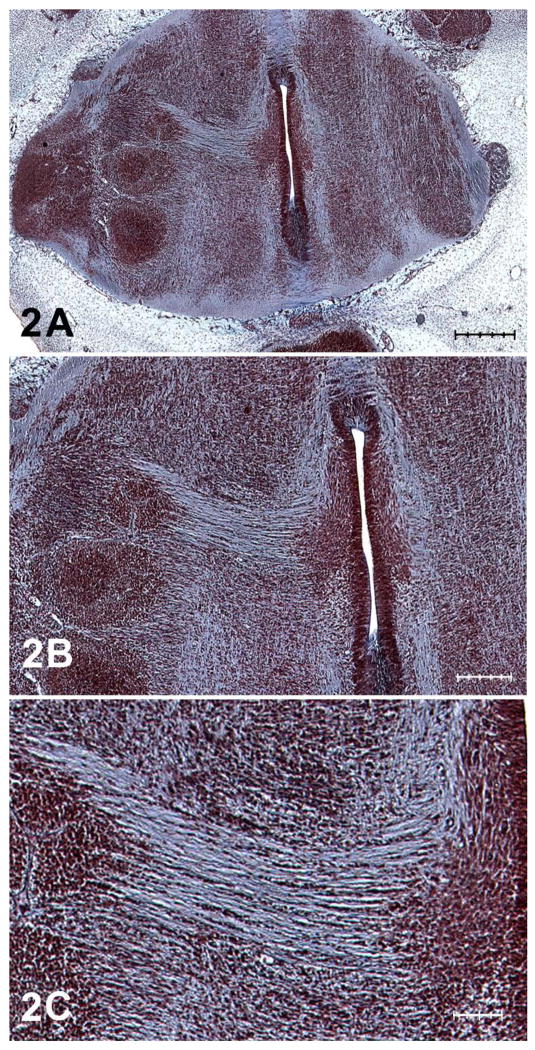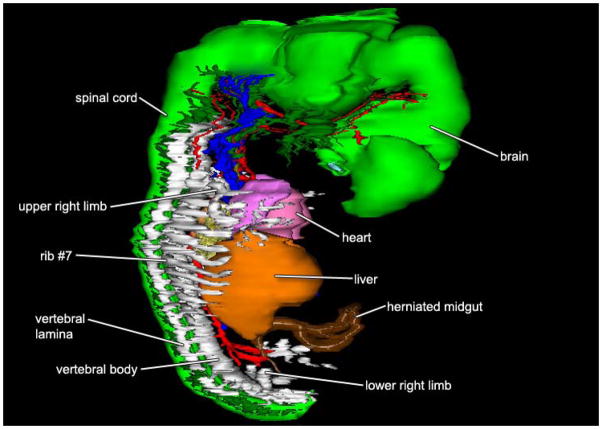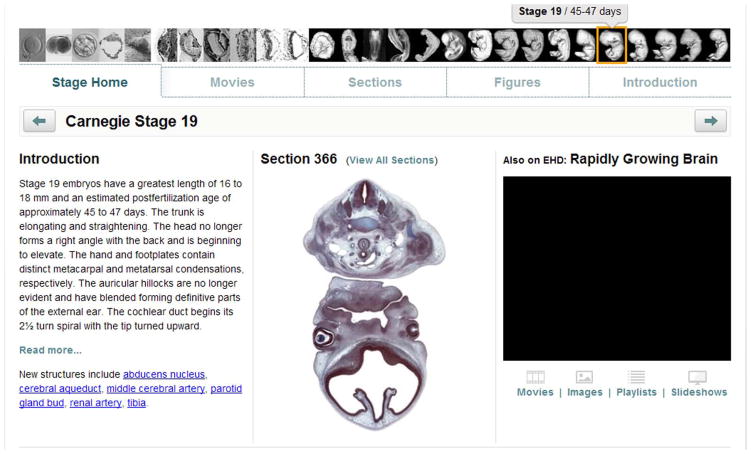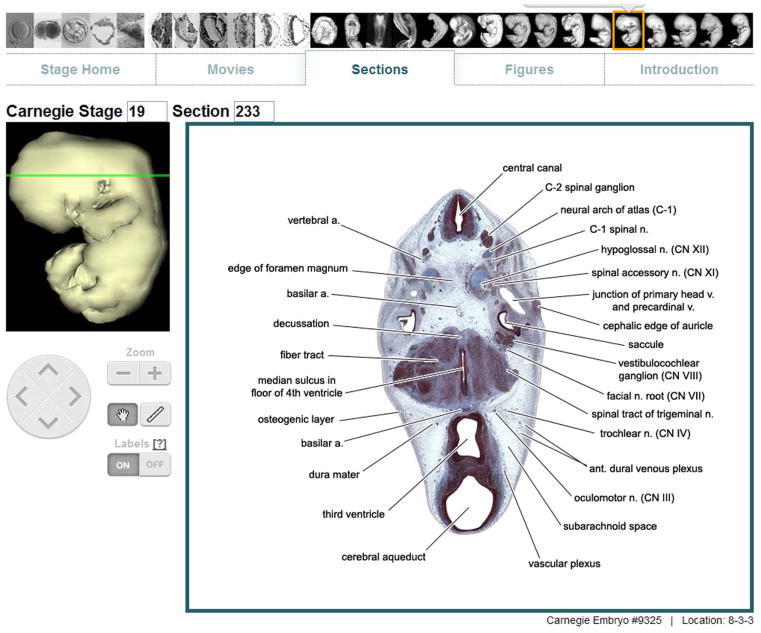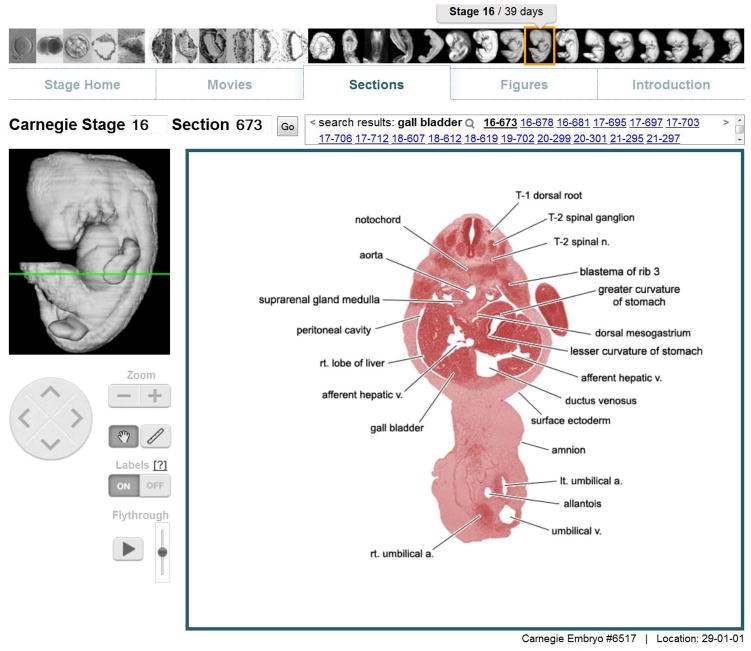BRIEF HISTORY
Prior to the latter part of the nineteenth century, human embryonic development was little more than a curiosity. Throughout history our ancestors raised questions about the manner in which humans develop, both normally and abnormally, but scant information was available. It was not until serious investigations began to answer specific questions about our formation that the field of human embryology became organized into a science.
The earliest publication of any significance was by Foster, et al. (1883). Their volume 2 dealt with the history of the mammalian embryo and contained a short section on the human that showed a few drawings of side views of embryos, a longitudinal section through part of the vertebral column at eight weeks, and an overview of the developing venous system. These drawings were not original but taken from various other sources. One of the leading human embryologists at the time was a Swiss anatomist named Wilhelm His, who is considered by some to be the founder and “Vesalius” of human embryology (Müller and O’Rahilly, 1986). His (1880–1885) published a series of side views of human embryos age 15 days to 8½ weeks. Because of their detail and accuracy many were reproduced in textbooks. As a result of his encouragement, one of his students, Franklin Mall, in 1887, began to collect human embryos that would later become the foundation of the internationally recognized Carnegie Collection of Human Embryos, which is housed today in the Human Developmental Anatomy Center (HDAC) at the National Museum of Health and Medicine in Washington, D.C.
The complex formation of the urogenital system, published in German, was the first indepth treatise of the formation of a body system (Keibel, 1896). Keibel also edited a landmark series of 16 volumes on vertebrate embryos (1897–1938) that defined for the first time standard divisions of human development by utilizing plates of normal embryos at multiple ages and included tables of their measurements. The volumes were a major rebuttal to Haeckel’s proposal that ontogeny recapitulated phylogeny.
Sometimes under appreciated and often overlooked is Kollman’s treatise on the external form of the human embryo (1889) and his two-volume hand atlas (1907), both published in German. He was the first to organize human development into chapters and subdivisions, and he introduced new terms for the human embryo such as mesoderm, myotome, and sclerotome. His concepts and drawings have been copied extensively and many are still used in current textbooks.
As more information on the human embryo became available in the first half of the twentieth century, it was progressively included in many textbooks. During this period many detailed descriptions of individual embryos were published and widely used in subsequent textbooks. A popular and, for its time, comprehensive, two-volume textbook became available in English (Keibel and Mall, 1910–1912). It was an important landmark because it was devoted exclusively to the human embryo, widely referenced many publications that were available at that time, and presented new topics such as the formation of the integument, coelom, and diaphragm. Wilson (1914) added substantially to the accumulation of descriptions of young embryos. However, images of early implanted specimens were especially lacking. It was not until the middle of the century that the work of Hertig and Rock (1941, 1945, 1949) helped substantially to fill this void. Some five years later a collection of pre-implantation specimens was published (Hertig, et al., 1954).
While the staging of human embryos was first introduced by His and Mall, it was Streeter (1942, 1945, 1948, 1951), O’Rahilly (1973), and O’Rahilly and Müller (1987) who were the main contributors to this method of studying human differentiation. After Streeter’s untimely death in 1948 Heuser and Corner (1957) published the description of Horizon X (Stage 10) with the aid of Streeter’s notes.
Streeter placed embryos in Horizons and titled each of them with Roman numerals. Later, O’Rahilly changed Horizon to Stage and titled each with Arabic numbers that are used today and are known as the Carnegie stages. Stage 1 (Horizon l) was defined as fertilization and Stage 23 (Horizon XXlll) was defined as the end of the embryonic period when the embryo is approximately eight weeks post fertilization age, has a greatest length of approximately 30 mm, and possesses about 4,000 definitive, permanent structures. Each stage was described in detail along with unique characteristics. The post-ovulation age and greatest length were given for each stage along with multiple micrographs of various views of intact embryos, samples of their sectional morphology, and many drawings of organ reconstructions. Each specimen was given a Carnegie number, sex when apparent, greatest length in mm, plane and thickness of sections in microns, and a grade of its microscopic condition. Sometimes a brief history of the specimen was given along with information on the histotechnique employed in preparing the specimen for microscopic study. Most of this data was initially published in separate volumes of Contributions to Embryology published by the Carnegie Institution of Washington. Streeter defined each Horizon and described the characteristics of older embryos beginning with Stage 11 (Horizon XI) thru Stage 23 (Horizon XXIII). Stages 1 through 9 were later defined and described by O’Rahilly (1973) who subdivided some of the early stages. Subsequently O’Rahilly and Müller (2001) revised the estimated ages using data from in vitro fertilizations (e.g., Sathananthan, 1984) and ultrasound (e.g., Dickey and Gasser, 1993).
Between 1942 and 1972 Blechschmidt constructed a very precise series of color-coded, 3D reconstructions of human embryos including every organ and cavity at representative stages. Based on the reconstructions new embryological findings were reported and published in German by Blechschmidt (1973, 1977). Blechschmidt and Gasser published in 1978 an English description of the growth movements that occur during the formation of specific tissues. Fields were described that explain the movements taking place as the cells; tissues and organs change their shape and position. It is remarkable that the movements in any given region are consistent at every level of magnification (i.e., cells, tissues and organs). In 1975 labeled histological sections of representative human embryos from the Carnegie Collection became available for the first time (Gasser, 1975). The level and plane of each section were indicated on line drawings made from reconstructions of multiple organs at representative stages. Because of space limitations of the printed format one selected embryo depicted the morphology each week for weeks four through eight.
A historic and astonishing event took place at this time with the revelation that a healthy baby was born from an in vitro fertilization and artificial implantation in the uterus (Steptoe and Edwards, 1978). Since then variations of this procedure have become routine in obstetrical practice as a method to overcome certain types of infertility. The success of in vitro fertilization (IVF) meant that the early pre-implantation embryos could now be observed in vitro, i.e., in the living state. IVF has revealed many details of fertilization and cleavage.
In 2003 a unique feat was accomplished with the announcement that the Human Genome Project was completed (e.g., Collins et al., 2003). The project was an international, 13-year effort to discover all the estimated 20,000–25,000 human genes and to determine the complete sequence of the three billion DNA subunits (base pairs in the human genome). This information has the potential of linking specific parts of the genetic code with specific embryonic formations, both normal and abnormal.
Over the years many terms used for the development of lower forms were being used in the terminology for human development, for example, branchial arch. The usage of such terms is misleading and sometimes causes confusion. A list of terms relevant to the human embryo was needed for clarity. Between 1997 and 2009 an international committee of anatomists, appointed by the International Federation of Associations of Anatomists (IFAA) democratically constructed a list of all terms related to human embryology. This committee, named the Federative International Committee for Anatomical Terminology (FICAT), placed the official list on the Internet in 2009. After the IFAA approved the list, a hard copy of the terms, including an index, was published in 2013 titled Terminologia Embryologica (TE). . Since there are no branchial or gill arches in the human, the arches are now more appropriately named “pharyngeal aches.” For the first time, a list of exclusively human embryonic terms was published in Latin and English. More recently the list has been translated and published in several other languages.
From this brief history one realizes that the science of human embryology evolved rather quickly, occurring over a period of about 130 years. Many dedicated and talented investigators brought this about, each moving the field forward. For the sake of brevity, however, many of the contributors are not mentioned. The future of this science holds great promise with the advent of stem cell and gene technologies. It promises to be an exciting venture revealing many remarkable details on how our species develops.
REBIRTH
Quality serial sections of human embryos at representative stages of development are limited to only a few collections worldwide. Anyone studying the actual sections realizes that enormous time is required to locate the needed sections. As it was impractical to ship the specimens to individual researchers, only a few were able to conduct in-depth investigations on the actual specimens. The expense of residing at the collection site for an extended period was prohibitive for most researchers. This situation resulted in relatively few original studies on human embryos. Adding to this handicap in the late twentieth century was the fact that some of the embryo sections in the Carnegie Collection were beginning to deteriorate with the passage of time. Some of the specimens had been prepared more than 50 years earlier. It was imperative that their microscopic morphology either be preserved or replaced with new specimens. When the collection was relocated to the HDAC there was great interest in preserving the collection. The advent of digital imaging technology seemed to be the solution but the necessary software, hardware, and technical staff would be very costly. Subsequently, the National Institutes of Health was convinced that making digital copies of the sections would solve many of the problems with the collection. First, digital copies would preserve the sectional morphology. Second, investigators could view the morphology on computer discs and the Internet and would no longer have to travel to the collection site. Lastly, the time required to identify a particular region in an embryo at a specific stage would be reduced substantially from hours to minutes or even seconds.
With financial support from the National Institute of Child Health and Human Development *(NICHD) (Grant # R01 HD37811, RFG, PI), the task began in 2000 and titled the VIRTUAL HUMAN EMBRYO (VHE) DREM Project. DREM is an acronym for Digitally Reproduced Embryonic Morphology. Shortly after the task began, R. John Cork (RJC) joined the project as the software developer with special interest in 3D computer reconstructions and imaging. In 2002 the National Library of Medicine (NLM) provided five years of additional support for the development of animation and reconstruction software (Grant # R01LM007591, RJC, PI). The NLM funds resulted in the construction of a subdivision of the VHE website entitled, HEIRLOOM (Human Embryo Imaging and Reconstruction Library Of Online Media), which provided greater access to the DREM databases, provided for the construction of the VHE website, and produced additional 3D reconstructions and animations. All of the HEIRLOOM data are included on the VHE-DREM disks and websites.
The overall aim of the project was to make the microscopic sectional morphology of these unique and very valuable specimens accessible to all researchers, teachers, and students interested in human embryology. A suitable stage 22 specimen was not available in the Carnegie Collection, so the sectional images of this stage are from a specimen in the Boyd Collection in Cambridge, England. The slides containing the sections were made available for the project courtesy of Professor Graham Burton, curator of that collection. The slides were mailed to the HDAC for digital imaging.
Images of selected serial sections at each of the 23 Carnegie stages were digitally captured by the staff of the HDAC under the supervision of Elizabeth Lockett. The digital data then were sent to the Computer Imaging Lab in the LSUHSC Department of Cell Biology and Anatomy in New Orleans, Louisiana.
Digital databases were assembled that contain the restored morphology of the best specimens sectioned in the Carnegie Collection at each of the 23 stages. At least one database was assembled for each stage. As many as 40 structures are labeled in each section image at the lowest magnification (i.e., zoom level 1), using the official terminology from Terminologia Embryologica throughout (Fig. 1). All body segments are identified as soon as they form. A total of approximately 14,250 web pages are included in the atlas, which took a team of computer imagers 12 years to assemble. The VHE DREM Project generated approximately 3,347 digitized, microscopic, section images with structure labels. When different magnification levels are included a total of 12,991 section images were generated. There are an additional 590 labeled figures, many with descriptions, and 252 movies, including flythrough animations and rotating 3D reconstructions. Overall, the project produced approximately 34 gigabytes of human embryonic imagery.
Figure 1.
A typical page on the VHE-DREM website. The section image is from the Browse part of the database of a Stage 19 embryo. It is displayed with labels at the lowest magnification and includes the section number (#233) and scale bar. On the left is a side view of a computer generated reconstruction of the specimen’s surface with a section indicator showing the section level and plane that can be moved up or down to higher or lower section images. Below the surface reconstruction are buttons that change the magnification of the section image as well as access other parts of the database.
The databases are available on CDs and DVDs for a nominal handling, shipping, and replacement fee. The CDs contain magnification level 1 but fewer of the higher magnification levels. Multiple early stages are contained on a single CD. All of the three to four magnification levels are on the DVD version. All of the databases can be viewed also on the Internet at: http://virtualhumaembryo.lsuhsc.edu.
Each database is divided into six components: INTRODUCTION, BROWSE, VIEW 3D, SCAN, INSTRUCTIONS, and CREDITS, all of which are listed and accessible on the Opening Screen. Developmental characteristics unique to the embryos at each stage are given in the INTRODUCTION along with details of the histological preparation of the specimen such as section thickness and references to previous publications. The BROWSE component occupies most of the database because it contains the restored, individual, section images. After selecting the beginning section image, it appears at the lowest magnification (Fig. 1). The section number and a movable and rotatable measuring scale are located at the top of each section image. From stage 5 onward the level and plane of the section image is shown at the left side of the screen either on a surface reconstruction or a micrograph of the specimen before it was sectioned. The level indicator line can be moved up or down to view any section image in the embryo. At the lower left are buttons that allow viewing other section images or navigating to other features in the database. Labels as well as other items can be turned on or off as desired for use in presentations, publications, and exams. Each section image can be viewed at up to four magnifications (Figs. 1, 2A, 2B, 2C). In VIEW 3D the color-coded, rotatable 3D reconstructions of the embryo’s internal organs can be studied (Fig. 3). SCAN presents flythrough animations of the aligned section images. Help with viewing or downloading any of the images is available in INSTRUCTIONS. Acknowledgements of the funding agencies, institutions, and individuals who helped assemble the database are given in CREDITS.
Figure 2. The same section image as in Figure 1 but with focus on a fiber tract in the pons region of the brainstem demonstrating three progressively higher magnifications.
A Magnification level 2. Scale bar length equals 400 microns.
B Magnification level 3. Scale bar length equals 200 microns.
C Magnification level 4. Scale bar length equals 100 microns.
Figure 3.
Right side view of a 3D reconstruction of the systems of the same embryo shown in Figure 1. Color code: brain, cranial nerves, and spinal cord: green; skeleton: white; heart: pink; arteries: red; veins: blue; lungs: yellow; liver: orange; midgut: brown.
All files can be copied for use in research, teaching, and student projects. Any publication of the data should acknowledge the source of the images, i.e., Virtual Human Embryo DREM Project. None of the files can be used in for-profit publications without the written consent of one of the PIs, Raymond F. Gasser or R. John Cork.
In 2011 the CEO of Endowment for Human Development (EHD), Brian Stillwell, agreed to host all of the VHE databases at: http://www.ehd.org/virtual-human-embryo/. The data are displayed in a very user-friendly manner. Any stage can be accessed by clicking on one of the specimens displayed across the top of each page (Fig. 4). Below them are buttons to view movies, other section images, figures, and various subdivisions of the displayed database. Any subdivision can be viewed simultaneously at the left of the section image. Hyperlinks to new structures present at the stage are listed in the lower left corner of the page.
Figure 4.
Example of a typical page from a VHE-DREM database as it appears on the EHD website. The unlabeled section image (#366) is from the same embryo shown in Figure 1. The text of the Introduction is displayed as an example on the left. Clicking on any one of the 27 specimens displayed along the top brings up the database for that specimen. Buttons displayed across the very top access movies, labeled serial section images, and figures of the stage displayed. At the bottom left is a list of the new structures that can be viewed in the appropriate section image by clicking on the hyperlink for that structure. An alphabetical index of all the labeled structures in all of the databases is available on this website.
When a particular section image is displayed (Fig. 5), its stage and section number are indicated at the top and the level and plane of the section image are indicated on a surface reconstruction displayed on the left. Section images at other levels can be displayed by clicking on a particular area in the reconstruction. Below the reconstruction is a navigation disk with four arrowheads. The arrowheads in the vertical plane that point upward or downward bring up the section image immediately above or below, respectively. The two arrowheads in the horizontal plane point either to the left or the right. This remarkable feature brings up a comparable section image at an earlier or later stage, respectively. Utilization of this feature permits one to compare changes that occur in a sequence of stages. To the right of the navigation disc are buttons that raise or lower the magnification of the section image, navigate to other areas of the image, turn on and off the labels, and use an easily maneuverable measuring tool that can determine quickly the dimensions of any structure with a boundary. The measuring tool can determine size changes over a sequence of stages. Clicking on the question mark opens the Abbreviation Key where all abbreviations used in the section images are defined. Unique and very valuable in the VHE-DREM data on the EHD website is a comprehensive index cataloging all the terms used for the labels in the section images, figures, and movies. Also very helpful is the ability to perform a custom search of the index to extract the precise subset of images containing any desired term for detailed serial reviews. For example, if the term, “bladder” is entered into the search field, a search results page with chronologically ordered hyperlinks to all related images is generated (Fig. 6). Continuing the previous example, clicking the first hyperlink adjacent to “gall bladder” generates the image viewer page (Fig. 7) with a search results box containing hyperlinks to all section images in which “gall bladder” is labeled. The user may then review each image sequentially while retaining all navigation, zoom, measurement, and label options. Clicking on the magnifying glass will regenerate the original search results page where the user may select a different related term or perform another search.
Figure 5.
Example of a typical labeled section image (#366) from the same embryo shown in Figure 1 as it appears on the EHD website. At the top left is a side view of the reconstructed specimen on which the section level and plane are indicated. The navigation disk below it makes possible viewing the next higher or lower section image by activating the up or down arrowheads, respectively. Activating of the left or right arrowhead will access a similar section image from an earlier or later stage, respectively. To the right of the disk are buttons that raise or lower the magnification level of the section image, navigate the section area, take measurements, and turn on and off labels. Clicking the “?” displays definitions of all abbreviations used in the databases.
Figure 6.
Example of a typical search results page on the EHD website showing a summary of all search results for the term “bladder” followed by each term and its related hyperlinks.
Figure 7.
Example of EHD’s image viewer page after clicking the first hyperlink following “gall bladder” on the previous figure. Hyperlinks to all serial section images with a gall bladder label are listed in the search results box found just above the section image. This allows immediate access to every section image containing the search term. Clicking the magnifying glass will regenerate the search results page previously shown in Figure 6.
The difficulties previously encountered in accessing the embryo sections resulted in a reduction of interest in and publications on morphogenesis in human embryos. The attitude of some investigators was that human morphogenesis had run its course and little was left to gain from examining the sections. Having access to indexed, high quality serial section images opens up new avenues for research and can advance our understanding of human embryology. There are many places that need further study. For example, some embryologists view human morphogenesis as taking place in isolated systems with little attention to the fact that solitary formations do not occur in the embryo. With the VHE data one can view the relationships of systems together at each stage of their formation. Other phenomena that need further study are the causes of various embryonic folds and flexures, which mainly continue to be an enigma. In addition to research based concepts multiple textbooks present some morphogenetic events that are not based on real events. An example is the depiction of heart septation occurring in a static heart. By using the measuring tool the size changes can be determined as the heart chambers are subdivided by septa.
Resources are now available in the VHE databases that will stimulate a renewed interest or “rebirth” in human morphogenesis. The availability of these unique and valuable images eliminates many of the handicaps previously encountered. They provide for the first time 3D, hololistic views of development enabling educators to utilize them in presentations and examinations. The changing shape and position of developing organs can be recorded in sequential databases similar to viewing frames of a motion picture film when a consistent reference point is used from one stage to the next (e.g. body segment). Since all movement is caused by force, the directions of forces causing the movements can be shone as long as they have a consistent direction at every level of magnification. The databases will provide researchers with the opportunity to correlate many of the parameters of human development as well as elucidate many of the gaps and misunderstandings that currently exist.
Bullet Points.
Brief history of human embryonic development
Features of the Virtual Human Embryo DREM (VHE) website
VHE features on The Endowment for Human Development (EHD) website
Acknowledgments
The authors thank Dr. Adrianne Noe, Director of the National Museum of Health and Medicine for her unwavering support of this project. We are indebted to the following imaging technicians and students for the many dedicated hours they spent generating the thousands of items in the databases: Sandie Blanchard, Jeff Claiborne, Dominique Coleman, Alice Cork, Erika Favorite, Kim Staci Green, Monica Herbert, Tinisha Monroe, Trey Perry, Zack St. Onge, Julie Toups, Amanda Roueche, Jeffrey Roussel, Rose Rowden and Carol Thouron. Lastly, we also thank Christine Putnam Anderson and Andrew Pepe for their many hours of volunteer service helping EHD catalog tens of thousands of labels to create the VHE index of terms.
Grant Sponsors: National Institute of Child Health and Human Development, # 5 RO1 HD 37811
National Library of Medicine, # 1 RO1 LM 007591
References
- Blechschmidt E. Die Pränatalin Organsysteme des Menschen. Stuttgart: Hipokrates Verlag; 1973. [Google Scholar]
- Blechschmidt E. The Beginning of Human Life. New York: Springer Verlag; 1977. [Google Scholar]
- Blechschmidt E, Gasser RF. Principles and Applications. Springfield, IL: Charles C. Thomas Publisher; 1978. Biokinetics and Biodynamics of Human Differentiation. [Google Scholar]
- Collins FS, Morgan M, Patrinos A. The Human Genome Project: Lessons from Large-Scale Biology. Science. 2003;300:286. doi: 10.1126/science.1084564. [DOI] [PubMed] [Google Scholar]
- Dickey RP, Gasser RF. Variability in the growth rate of human embryos resulting from IVF and GIFT as determined by vaginal ultrasound. Anat Rec. 1993;236:47. [Google Scholar]
- Foster M, Balfour FM, Sedgwick A, Heape W. The Elements of Embryology. Vol. 2 The History of the Mammalian Embryo. London: Macmillan Co; 1883. [Google Scholar]
- Gasser RF. Atlas of Human Embryos. Hagerstown: Harper and Row Publishers; 1975. p. 318. [Google Scholar]
- Hertig AT, Rock J. Two human ova of the pre-villous stage, having an ovulation age of about eleven and twelve days, respectively. Contrib Embryol Carnegie Inst. 1941;29:127–156. [PubMed] [Google Scholar]
- Hertig AT, Rock J. Two human ova of the pre-villous stage, having a development age of about eight and nine days, respectively. Contrib Embryol Carnegie Inst. 1945;33:169–186. [PubMed] [Google Scholar]
- Hertig AT, Rock J. Two human ova of the pre-villous stage, having a development age of about seven and nine days respectively. Contrib Embryol Carnegie Inst. 1949;31:65–84. [PubMed] [Google Scholar]
- Hertig AT, Rock J, Adams EC, Mulligan WJ. On the preimplantation stages of the human ovum: A description of four normal and four abnormal specimens ranging from the second to the fifth day of development. Contrib Embryol Carnegie Inst. 1954;35:199–220. [Google Scholar]
- Hertwige O. Lehrbuch der Entwickelungsgeschichte des Menschen und der Wirbeltiere. Jena; 1906. [Google Scholar]
- Heuser CH, Corner GW. Developmental horizons in human embryos. Description of age group X, 4 to 12 somites. Contrib Embryol Carnegie Inst. 1957;36:29–39. [Google Scholar]
- His W. Anatomie menschlicher Embryonen. Leipzig: Vogel; 1880–1885. [Google Scholar]
- Keibel F. Zur Entwicldungsgesohichte des menschlichen Urogenitalapparates. Arch f Anat u Physiol Anat Abtm. 1896:55–156. [Google Scholar]
- Keibel F, Mall FP. Manual of Human Embryology. Vol. 2. Philadelphia: JB Lippincott Co; 1910–1912. [Google Scholar]
- Kollman J. Der Korperform menschlicher normalerund pathologischer Embryonen. Arch Anat Emtw, Anat Abth Suppl Band. 1889:105–138. [Google Scholar]
- Kollman J. Handatlas der Entwicklunsgeschichte des Menschen. Vol. 2. Jena: Fische; 1907. [Google Scholar]
- Müller F, O’Rahilly R. Wilhelm His and 100 years of human embryology. Acta Anat. 1986;125:73–5. [PubMed] [Google Scholar]
- O’Rahilly R. Developmental stages in human embryos, including a survey of the Carnegie collection. Part A: Embryos of the first three weeks (Stages 1 to 9) Carnegie Inst Publ 631; Washington, D.C: 1973. [Google Scholar]
- O’Rahilly R. One hundred years of human embryology. Issues Rev Teratol. 1988;4:81–128. [Google Scholar]
- O’Rahilly R, Müller F. Developmental Stages in Human Embryos. Carnegie Inst Wash Publ 637; 1987. p. 306. [Google Scholar]
- O’ Rahilly R, Müller F. Human Embryology & Teratology. 3. New York: John Wiley and Sons Inc; 2001. [Google Scholar]
- Sathananthan AH. In Vitro Fertilization. Embryo. London: Churchill Livingstone; 1984. Ultrastructural morphology of fertilization and early cleavage in the human. [Google Scholar]
- Steptoe PC, Edwards RG. Birth after the reimplantation of a human embryo. Lancet. 1978;2:366. doi: 10.1016/s0140-6736(78)92957-4. [DOI] [PubMed] [Google Scholar]
- Streeter GL. Developmental horizons in human embryos. Description of age group Xl, 13 to 20 somites and age group Xll, 21 to 29 somites. Contrib Embryol Carnegie Inst. 1942;30:211–245. [Google Scholar]
- Streeter GL. Developmental horizons in human embryos. Description of age group Xlll, embryos about 4 to 6 mm long, and age group XlV, period of indentation of the lens vesicle. Contrib Embryol Carnegie Inst. 1945;31:27–63. [Google Scholar]
- Streeter GL. Developmental horizons in human Embryos. Description of age groups XV, XVl, XVll and XVlll, being the third issue of a survey of the Carnegie Collection. Contrib Embryol Carnegie Inst. 1948;32:133–203. [Google Scholar]
- Streeter GL. Developmental horizons in human embryos; description of age groups XIX, XX, XXI, XXII, and XXIII being the fifth issue of a survey of the Carnegie collection. Contrib Embryol Carnegie Inst. 1951;34:165–196. [Google Scholar]
- Terminologia Embryologica. Stuttgart: Thieme Publishers; 2013. [Google Scholar]
- Wilson JT. Observations upon young human embryos. J Anat Physiol. 1914;48:315–51. [PMC free article] [PubMed] [Google Scholar]



